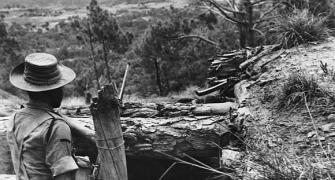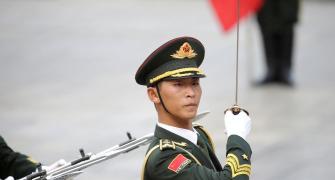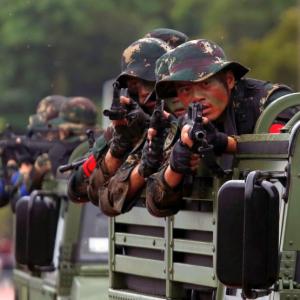 From March 1959 to March 1962, the PLA fought 12 major battles in central Tibet which was seen as an opportunity to train China's soldiers, notes Ajai Shukla.
From March 1959 to March 1962, the PLA fought 12 major battles in central Tibet which was seen as an opportunity to train China's soldiers, notes Ajai Shukla.
In pathbreaking research into the Tibetan uprising between 1956 and 1959, and the lead-up to the 1962 war, Chinese scholar Jianglin Li has accessed Chinese Communist Party documents and interviewed People's Liberation Army veterans from that war to present critical new aspects of that period's history.
Li's research illustrates that Mao Zedong cynically regarded operations against the Tibetan resistance -- called Chushi Gangdruk -- as an opportunity to train the PLA.
This research rebuts earlier claims by 1962 war veterans like Yin Fatang, a former Chinese Communist Party boss in Tibet, that the PLA fought the 1962 war unprepared.
A similar claim was made in the 2008 memoir of Ding Sheng who commanded the PLA's 54th Army in the Walong sector.
Ding said that in October 1962, the 54th Army was scattered across Sichuan for agricultural work.
On October 28, 1962, when he received the order to attack Walong, 'the troops were hastily mobilised, issued warm clothing and rushed to Tibet for the battle at short notice,' Ding claimed.
Li's research -- which is posted on the War on Tibet Web site in a research article entitled 'Suppressing Rebellion in Tibet and the China-India Border War' -- shows the PLA presented a formidable contrast to the poorly equipped and poorly acclimatised Indian troops.
Chinese Communist Party documents indicate that, in the three years from March 1959 to March 1962, the PLA fought 12 major battles in central Tibet, targeting the Tibetan resistance force called the Chushi Gangdruk.
Li concludes that, when the 1962 war began, 'It had been less than a year since Ding's troops pulled back from Tibet after three years of fighting.'
Beijing's hostility came even though India helped China sustain its occupation of Tibet.
According to a book, Remembering Tibet -- Collected Recollections of Advancing and Liberating Tibet: 'In the early 1950s, China needed India's help to send supplies into Tibet so that the PLA could consolidate the occupation. India was quite generous in providing this help.'
In 1952, Beijing 'used diplomatic channels' to ship 2,500 tons of rice from Guangdong province to Calcutta, and transport it up to Tibet through Yadong (Dromo).'
By April 1953, all the rice had arrived. This basically solved the food supply problem for PLA troops, and enabled them to establish a preliminary footing in Tibet, the book said.
After discovering the existence of the border dispute in 1952, when the Chinese foreign ministry 'absorbed the former foreign office of the Kashag (Tibetan government) and acquired its archival documents', then Chinese premier Zhou Enlai sought to buy time.
'India is still under British and American influence, so we want to win it over... (Border disputes) should be solved in future due to insufficient documents now,' Zhou's 1954 directive on the border issue said, according to Wang Gui of the Tibet Military Command Political Department.
Unlike the patient Zhou, Mao had decided to teach India a lesson by end-March 1959 soon after the Tibet uprising and the Dalai Lama's escape to India.
Wu Lengxi, who headed Xinhua and the People's Daily at that time, describes Mao fuming at a party central committee meeting in Shanghai: 'Let the Indian government commit all the wrongs for now. When the time comes, we will settle accounts with them.'
The PLA aggression on the McMahon Line started right away, says Wang Tingsheng of the 54th Army Division.
His memoirs recount: 'PLA soldiers crossed the McMahon Line at three locations in pursuit of escaping Tibetans.'
Even so, Mao carefully lulled India into complacency, ordering the inclusion of a paragraph into a May 15, 1959 letter from Beijing to New Delhi: 'China's main attention and principle of struggle is focused on the east, the West Pacific region, on the ferocious American imperialism, not on India, the southeast or south Asian countries at all.'
'China will not be so stupid as to make enemies with the US in the east, and make enemies with India in the west. Pacification of rebellion and implementing democratic reform in Tibet would pose no threat to India whatsoever.'
At the time Mao made this statement, the PLA 11 Infantry Division was already fighting the Tibetan resistance in Chamdo.
Three years later, on October 20, 1962, this battle-hardened division would start the Sino-India war with its attack on Indian positions on the Namka Chu rivulet, near Tawang.
Li shows that Mao viewed operations against the Tibetan resistance as training ground for the PLA, causing the use of disproportionate force and war fighting weaponry against Tibetan civilians.
From January 22 to February 19, 1959, Mao added written instructions to four reports on the Tibet situation, stating: 'Rebellion is a good thing' as it could be used to 'train the troops and the masses', and to 'harden our troops to combat readiness.'
Xu Yan, a professor at the Chinese National Defence University, says the key differentiator in the 1962 war was combat experience.
'Most of the troops who fought at the China-India border have a glorious history,' he commented.
'Besides that, they had also acquired rich combat experience in high and cold mountain regions in the five years from the Khampa rebellion in 1956 to the end of the suppression of Tibetan rebellion in 1961.'
IMAGE: Chinese and Indian soldiers face off during the 1962 war. Photograph: Deshakalyan Chowdhury/AFP/Getty Images









